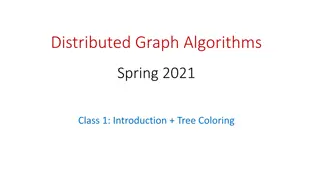BiGraph: Bipartite-Oriented Distributed Graph Partitioning for Big Learning
BiGraph is a distributed graph partitioning algorithm designed for bipartite graphs, offering a scalable solution for big data processing in Machine Learning and Data Mining applications. The algorithm addresses the limitations of existing partitioning methods by efficiently distributing and managing edges using randomized vertex-cut techniques, reducing execution time and improving scalability for large graph datasets.
Download Presentation

Please find below an Image/Link to download the presentation.
The content on the website is provided AS IS for your information and personal use only. It may not be sold, licensed, or shared on other websites without obtaining consent from the author. Download presentation by click this link. If you encounter any issues during the download, it is possible that the publisher has removed the file from their server.
E N D
Presentation Transcript
Institute of Parallel and Distributed Systems IPADS BiGraph: Bipartite-oriented Distributed Graph Partitioning for Big Learning Rong Chen, Jiaxin Shi, Binyu Zang, Haibing Guan Institute of Parallel and Distributed Systems (IPADS) Shanghai Jiao Tong University http://ipads.se.sjtu.edu.cn/
Bipartite graph All vertices are divided into two disjoint sets U and V Each edge connects a vertex in U to one in V 4 1 5 2 6 3 7 8
Bipartite graph A lot of Machine Learning and Data Mining (MLDM) algorithms can be modeled as computing on bipartite graphs Recommendation (movies & users) Topic modeling (topics & documents)
Issues of existing partitioning algorithms Offline bipartite graph partitioning algorithms Require full graph information Cause lengthy execution time Not scalable to large graph dataset
Issues of existing partitioning algorithms General online partitioning algorithms Constrained vertex-cut [GRADES 13] A lot of replicas and network communication
Randomized Vertex-cut Load edges from HDFS Distribute edges using hash e.g. (src+dst)%m+1 Create mirror and master
Randomized Vertex-cut 1. Distribute the edges part1 part2 part3 part4 1 8 2 8 1 6 1 7 1 12 4 6 2 5 1 11 2 7 4 10 2 9 3 9 3 10 4 11
Randomized Vertex-cut 2. Create local sub-graph part1 part2 part3 part4 8 2 8 1 6 7 1 12 4 6 2 5 1 11 2 7 10 9 3 9 3 10 4 11
Randomized Vertex-cut 3. Set vertex as master or mirror part1 part2 part3 part4 8 2 8 1 6 7 1 12 4 6 2 5 1 11 2 7 10 9 3 9 3 10 4 11 mirror master
Constrained Vertex-cut Load edges from HDFS Distribute edges using grid algorithm Create mirror and master
Constrained Vertex-cut Arrange machines as a grid Each vertex has a set of shards e.g. Hash(s)=1, shard(s)={1,2,3} Assign edges to the intersection of shards. e.g. Hash(t)=4, shard(t)={2,3,4} Then edge <s,t> will be assigned to machine 2 or 3 Each vertices has at most 3 replicas. 1 2 3 4
Existing General Vertex-cut If the graph is dense, the replication factor of randomized vertex-cut will close to M. (M: #machines) General Vertex-cut is oblivious to the unique features of bipartite graphs If M=p*q , the replication factor of constrained vertex-cut has an upbound p+q-1
Challenge and Opportunities Real-world bipartite graphs for MLDM are usually skewed e.g. netflix dataset 17,770 movies and 480,189 users
Challenge and Opportunities The workload of many MLDM algorithms may also be skewed e.g. Stochastic Gradient Descent (SGD) Only calculates new cumulative sums of gradient updates for user vertices in each iteration
Challenge and Opportunities The size of data associated with vertices can be critical skewed e.g. Probabilistic inference on large astronomical images Data of observation vertex can reach several TB, while the latent stellar vertex has only very few data
Our contributions Bipartite-cut and greedy heuristic Reduce memory consumption (62% replicas) Reduce network traffic (78%-96% network traffic) Data affinity Further reduce network traffic in partitioning phase (from 4.23GB to 1.43MB)
Bipartite-oriented Partitioning Observation If the related edges of a vertex are all in the same machine, then the vertex will not have any mirrors Main idea Completely avoid mirrors for all vertices in favorite subset Replication factor is close to 1 for skewed graphs
Bipartite-cut algorithm 1. Choose a favorite subset from the two sets Usually the subset with more vertices 2. Evenly assign the favorite vertices to machine with all adjacent edges 3. Construct masters and mirrors for non- favorite subset No mirrors for favorite vertices!
Bipartite-cut Assign edges according to the favorite subset U V 1 2 part1 part2 part3 7 3 1 7 2 7 3 7 4 8 5 4 8 3 8 5 8 6 6 7 6 8 Favorite subset
Bipartite-cut U part1 part2 part3 V 1 No mirrors for favorite vertices! 2 7 1 7 2 7 3 7 3 Upbound: (U+V*M)/(U+V) 1 4 8 6 8 5 8 4 8 5 6 Favorite subset
Greedy Heuristic Observation: Arbitrarily partitioning of favorite subset may not introduce any replicas Favorite vertex knows the location of neighbors Main idea: Use an additional round of edge exchange to reduce the mirrors of non-favorite vertices
Greedy Heuristic U part1 part2 part3 V 1 2 7 1 7 2 7 3 7 3 4 8 3 8 5 8 4 8 6 7 5 6 8 6 Favorite subset
Greedy Heuristic U part1 part2 part3 V 1 2 7 1 7 4 8 3 7 3 2 6 8 5 4 8 5 6 Favorite subset
Greedy Heuristic Algorithm Evenly assign the favorite vertices to machine with all adjacent edges For every favorite vertices v, Use formula N v Si Ei to decide target machine. Neighbors of v in machine i
Greedy Heuristic Algorithm Evenly assign the favorite vertices to machine with all adjacent edges For every favorite vertices v, Use formula N v Si Ei to decide target machine. keep balance Neighbors of v in machine i
Greedy Heuristic Algorithm Evenly assign the favorite vertices to machine with all adjacent edges For every favorite vertices v, Use formula N v Si Ei to decide target machine. Resend v with adjacent edges to target machine. Construct masters and mirrors for non-favorite subset
Greedy Heuristic Algorithm 7 1 8 1 10 1 7 4 8 4 10 4 11 4 part1 part2 part3 12 4 E: 0 0 0 Favorite subset
Greedy Heuristic Algorithm Ei 2 0 1 0 0 0 N v Si 7 1 8 1 10 1 7 4 8 4 10 4 11 4 part1 part2 part3 12 4 E: 0 0 0 Favorite subset
Greedy Heuristic Algorithm Ei 2 0 1 0 0 0 N v Si 7 4 7 1 8 4 8 1 10 4 10 1 11 4 part1 part2 part3 12 4 E: 3 0 0 Favorite subset
Greedy Heuristic Algorithm Ei 2 3 2 0 1 0 N v Si 7 4 7 1 8 4 8 1 10 4 10 1 11 4 part1 part2 part3 12 4 E: 3 0 0 Favorite subset
Greedy Heuristic Algorithm 7 4 8 4 7 1 10 4 8 1 11 4 10 1 12 4 part1 part2 part3 E: 3 5 0 Favorite subset
Execution Flow of Existing Systems Load file from HDFS (network) Distribute edges and vertices data (network) Construct local graph Computation What if the data size of one subset is very large?
Execution Flow of Existing Systems Load file from HDFS (network) Distribute edges and vertices data (network) Construct local graph Computation What if the data size of one subset is very large?
Exploiting Data Affinity Main idea Choose that subset as favorite subset (no mirrors) split files into multiple blocks and stored on multiple machines (load from local machine) Construct Mapping Table (id->machine) for favorite subset Distribute Mapping Table instead of favorite vertices data Distributed edges using Mapping Table.
Execution Flow of Existing Systems Edges and all vertices
Execution Flow with Data Affinity Edges and non-favorite vertices
Implementation BiGraph Based on latest version of GraphLab Compatible with all existing applications BiCut and Aweto (Greedy Heuristic) Source Code: http://ipads.se.sjtu.edu.cn/projects/powerlyra
Experiment Settings Platform 6X12-core AMD Opteron (64G RAM, 1GigE NIC) Graph Algorithms SVD , ALS , SGD Workload 6 real-world dataset1 1http://snap.stanford.edu/data/ and http://www.cise.ufl.edu/research/sparse/matrices/index.html
Replication Factor of Partitioning 5 Grid BiCut Aweto 4.0 Replication factor 4 3.1 3.1 3.0 2.9 2.8 3 2.5 2.3 2.1 1.8 2 1.5 1.6 1.6 1.3 1.3 1.3 1.2 1.2 1 0 LJ AS WG RUCCI SLS ESOC
Computation Speedup 20 Grid BiCut Aweto 18 Normalized Speedup 16 14 12 10 8 6 4 2 0 LJ AS WG SLS ESOC RUCCI SLS ESOC RUCCI SVD ALS SGD
Partitioning Speedup 3 Grid BiCut Aweto Normalized Speedup 2.5 2 1.5 1 0.5 0 LJ AS WG SLS ESOC RUCCI SLS ESOC RUCCI SVD ALS SGD
Data Affinity Evaluation Case Study: calculate the occurrences of a user-defined keyword touched by Users on a collection of Webpages Experiment Setting 84,000 webpages: 10-100 KB 4,000 users: 4 bytes integer
Data Affinity Evaluation Result comparing with Grid Rep-factor: 1.23 vs. 3.55 Network traffic (partitioning): 1.43MB vs. 4.23GB Performance (partitioning): 6.7s vs. 55.7s
Conclusion We identified the main issues in large-scale graph analytics framework for bipartite graphs We propose a new set of graph partitioning algorithms , leveraged three key observations from bipartite graph
Institute of Parallel and Distributed Systems Thanks Thanks IPADS Questions BiGraph http://ipads.se.sjtu.edu.cn/ projects/powerlyra.html























